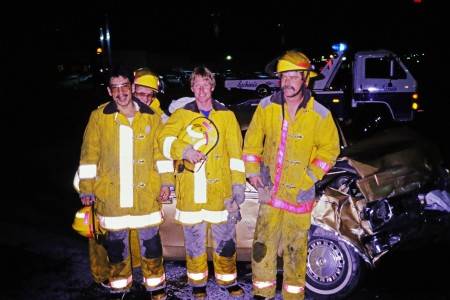TRAUMA ASSESSMENT (GENERAL)
General
The assessment of a trauma patient differs significantly from that of a medical patient. Issues like time management, rapid physical assessment, and timely transport are important. When dispatched to a “trauma patient” little information is made available often to the responding EMT. Trauma can produce isolated injury, generalized injuries, immediate life threats, and even traumatic arrest.
Assessment
Any level of EMT is capable of a proper trauma assessment. Time is of the essence.
1. A full history may not be available from the patient or bystanders or family. The mechanism of injury is important to determine with as much detail as possible. Chief complaints, past medical history, and medication may be spotty or unavailable. The primary medication that may be relevant is a blood thinner (Eliquis, Xarelto, Warfarin). If possible, attempt to determine if a medical incident caused the ensuing trauma. These scenes may be chaotic and a team approach with proper delegating of tasks can be helpful.
2. The primary survey (X-ABC’s) is easily conducted. “X” for hemorrhage.
3. A rapid secondary (head-to-toe) examination is indicated.
a. As much as can be practically done the patient should be exposed.
b. The first order of business is to look for potential life threats including hemorrhage, abnormal vital signs (hypotension, tachycardia, tachypnea, low oxygen saturation, and altered mental status).
c. Identification of signs of blunt trauma to the head, neck, chest, abdomen, pelvis, and extremities should be sought.
d. Penetrating trauma may be in multiple locations and a search for all entry and exit wounds needs to be conducted.
e. As each life-threat is identified an intervention may be called for before further assessment is conducted.
f. The assessment may be more complicated if a medical cause of the incident is found or suspected.
Treatment
Treatment for trauma patients is detailed in other guidelines. Timely transport is often indicated in trauma patients compared to the traditional medical patient where much can be done on-scene.
General
The assessment of a trauma patient differs significantly from that of a medical patient. Issues like time management, rapid physical assessment, and timely transport are important. When dispatched to a “trauma patient” little information is made available often to the responding EMT. Trauma can produce isolated injury, generalized injuries, immediate life threats, and even traumatic arrest.
Assessment
Any level of EMT is capable of a proper trauma assessment. Time is of the essence.
1. A full history may not be available from the patient or bystanders or family. The mechanism of injury is important to determine with as much detail as possible. Chief complaints, past medical history, and medication may be spotty or unavailable. The primary medication that may be relevant is a blood thinner (Eliquis, Xarelto, Warfarin). If possible, attempt to determine if a medical incident caused the ensuing trauma. These scenes may be chaotic and a team approach with proper delegating of tasks can be helpful.
2. The primary survey (X-ABC’s) is easily conducted. “X” for hemorrhage.
3. A rapid secondary (head-to-toe) examination is indicated.
a. As much as can be practically done the patient should be exposed.
b. The first order of business is to look for potential life threats including hemorrhage, abnormal vital signs (hypotension, tachycardia, tachypnea, low oxygen saturation, and altered mental status).
c. Identification of signs of blunt trauma to the head, neck, chest, abdomen, pelvis, and extremities should be sought.
d. Penetrating trauma may be in multiple locations and a search for all entry and exit wounds needs to be conducted.
e. As each life-threat is identified an intervention may be called for before further assessment is conducted.
f. The assessment may be more complicated if a medical cause of the incident is found or suspected.
Treatment
Treatment for trauma patients is detailed in other guidelines. Timely transport is often indicated in trauma patients compared to the traditional medical patient where much can be done on-scene.
